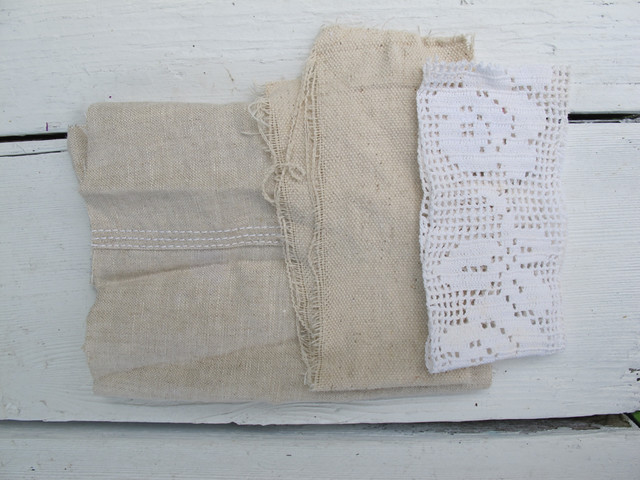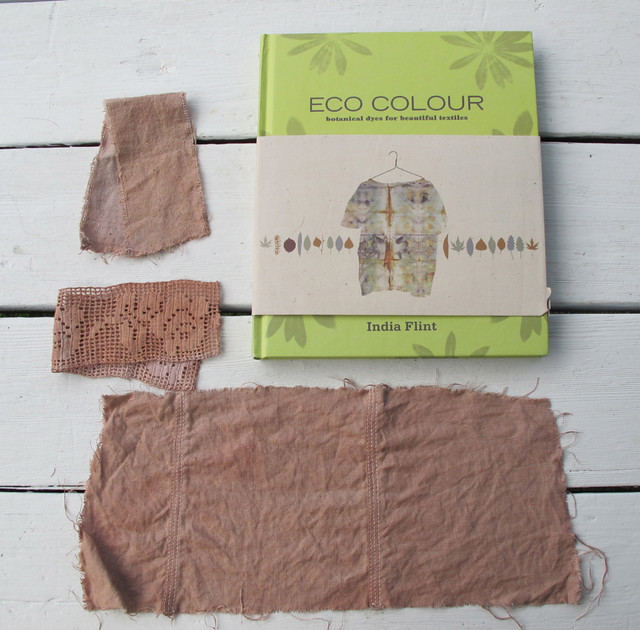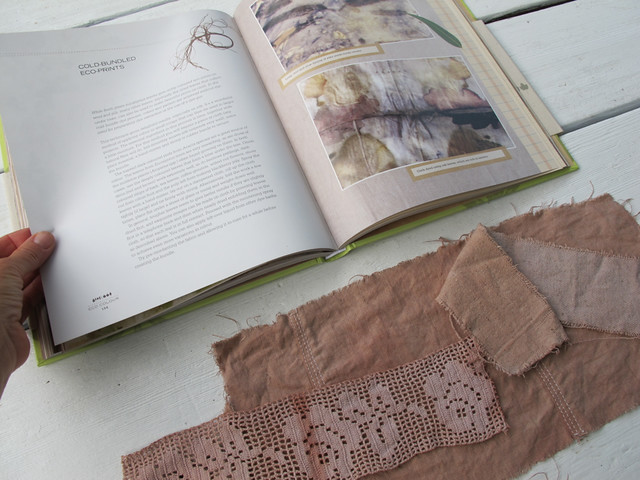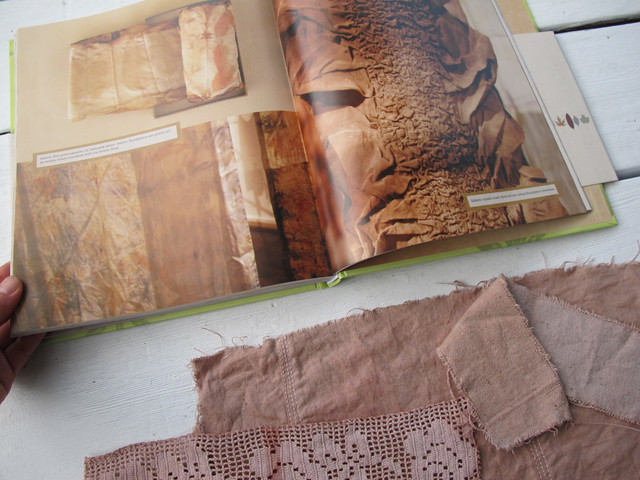 As you may have gleaned from my maya*mail last week... I'm getting back in the saddle! Those aronia berries from our dinner party were calling me. I save a handful for a mini dyeing experiment. I didn't follow any rules since I just wanted to allow my intuition to lead the way back to my inspiration point. I threw the berries into a pot of water and simmered them for a good long time.
As you may have gleaned from my maya*mail last week... I'm getting back in the saddle! Those aronia berries from our dinner party were calling me. I save a handful for a mini dyeing experiment. I didn't follow any rules since I just wanted to allow my intuition to lead the way back to my inspiration point. I threw the berries into a pot of water and simmered them for a good long time.

I added some fabric and lace scraps and boiled them too. Since I didn't use a mordant, I won't be using this material for something that needs washing, although it's surprisingly color-fast. Perhaps a pouch. I tossed in a zipper with cotton webbing at the last minute, just in case I go that route. It's just a small beginning... a little step past my tea and tumeric dyeing, but oh my!
 I'm all fired up now! I've been pouring through the pages of India Flint's Eco Colour and can't wait to set up some dyeing experiments this fall.
I'm all fired up now! I've been pouring through the pages of India Flint's Eco Colour and can't wait to set up some dyeing experiments this fall.


 My gardens have plenty of lupine leaves and our land is filled with giant black walnut trees. I think I'll begin there... but then there is also this book, Harvesting Color, to explore and zinnias to pick.
My gardens have plenty of lupine leaves and our land is filled with giant black walnut trees. I think I'll begin there... but then there is also this book, Harvesting Color, to explore and zinnias to pick.
 It's so fun to feel that invigorating charge of something new and right! Do you have any exciting paths to follow this fall? If not, why not start brainstorming now. A new season always calls for fresh starts and inspired beginnings!
It's so fun to feel that invigorating charge of something new and right! Do you have any exciting paths to follow this fall? If not, why not start brainstorming now. A new season always calls for fresh starts and inspired beginnings!


This is so interesting. I'd love to try dying my own fabrics one day
ReplyDeleteOh, how beautiful!
ReplyDeleteYou got an awesome color ! Isn't natural dyeing addictive, thrilling & fun ? I could do it everyday if it was possible ! Thank you for your kindness, my friend. I love how online friends can be inspiring or motivating or supporting each others, sometimes evn without knowing. Love to you, Maya ! Enjoy your future natural dyeing experiments ! Wishing I could dye with you & Margie & other dyeing buddies ! :)
ReplyDeleteoxox
Beautiful! I have been looking forward to getting Rebecca's book in my hands and now I need to get India's book too. I have not done much dyeing lately and I am so ready to start anew. Here's to fresh starts and new beginnings!
ReplyDeleteLovely. I had planned on planting some plants just for their dye, but never got around to it. This post has reignited that plan. Mordants frighten me though!
ReplyDeleteI am all about the fiber, my MIL even bought me a drum carder for Cmas last year, but I am intimidated by dyeing. I don't know why. Maybe it's because when I finally dive in I won't be able to stop?
ReplyDeleteThat is funny, I just took a pot off my stove in which have been simmering some rhubarb leaves that were left from the rhubarb stems I harvested today. I'd read in Jenny Dean's 'Wild Color (a very inspirational book and a dyers classic) that rhubarb leave solution is a natural mordant for animal fibers. I am for several years highly attracted to natural dying and tried a little bit so now and then (onion skins, turmeric and lately a natural fermentation indigo vat!). I hope that with my rhubarb leave solution I will continue to discover the magic of natural dying.
ReplyDeleterhubarb and wool.... fermented indigo vats... all sounds exciting, Heleen!
DeleteMy son's scouting group may try to do some natural dyeing this year. And my daughter's nature club will be too. Thanks for the resources to help us out!
ReplyDeleteThe absolute best thing about Harvesting Color is discovering something good about pokeweed! I've got tons of the horrid stuff in an empty lot -- I can't imagine anyone planting it on purpose -- but that deep red color is gorgeous. Now the problem is that I think the birds have gotten to the berries before me. Maybe next year . . .
ReplyDeleteThere's always next year with pokeweed... something you can count on;)
DeleteWelcome to the wonderful, and very addictive, world of natural dyes Maya! Have fun! :)
ReplyDeletefantastic! i had the same two books on loan from our library at the beginning of summer! i dye all my store tags with onion or hibiscus and i love the varying tones i get. i have three large cotton crocheted bedspreads that i am going to try dying with the hibiscus but i want to use a mordant and havent decided what yet. i want to learn about indigo vats!! xxx jennette
ReplyDeleteBeautiful pictures and the post..loved it
ReplyDeleteHi Maya...I have also been consumed with the desire to do a lot of dyeing lately. I have the second book you show here and it is AMAZING! An absolute visual feast. I tried the tansy with some handspun wool (I am a beginner so it is crafting wool not knitting wool) and it was incredible. I posted it here http://alittlecraftynest.typepad.com/a-little-crafty-nest/2012/08/tansy.html in case you want to see it? I look forward to checking out the other book, thank you.
ReplyDeletexo Jules
P.S. I enjoyed reading your empty nest post...your mom sounds like a good friend!
Dear Maya,
ReplyDeletesome years ago, I also made a little experiment with aronia berries. I had made some liqueur from the berries (which is tart, but nevertheless delicious) and after straining them from the liquid, I didn't want to through them away. As they are too hard to be eaten as such (like I might have done with other, softer fruit), I decided to put them into a mason jar glass, and add a little silken scarf I had. Without the addition of other substances (maybe just a little alcohol from the liquer), after two days, it had taken on the wonderful reddish brown hue, just like the one on your photos. It has faded little in the meantime, even after two accidental runs in the washing machine. Maybe sometimes random experiments bring out the best results?
I'm eager to hear more of your experiments! Thanks for sharing!